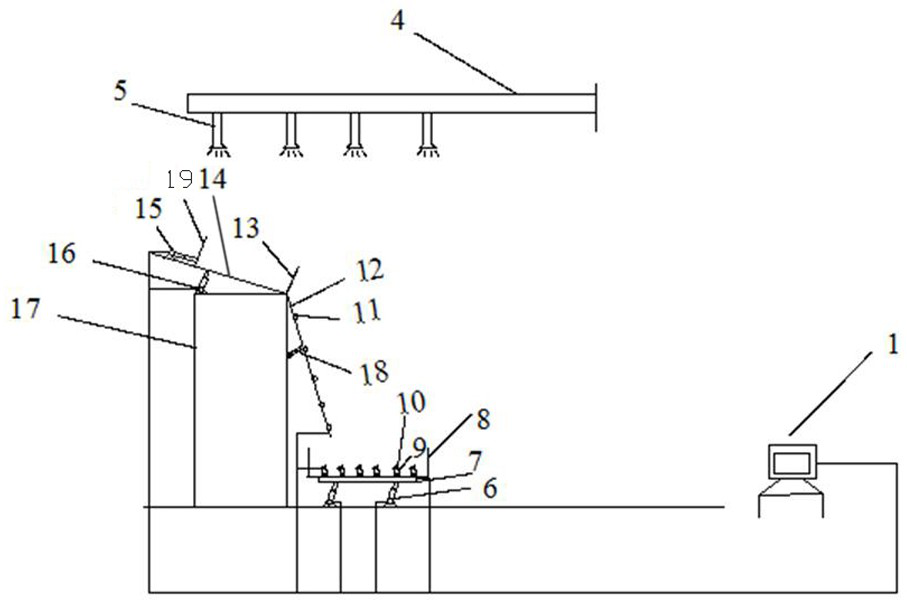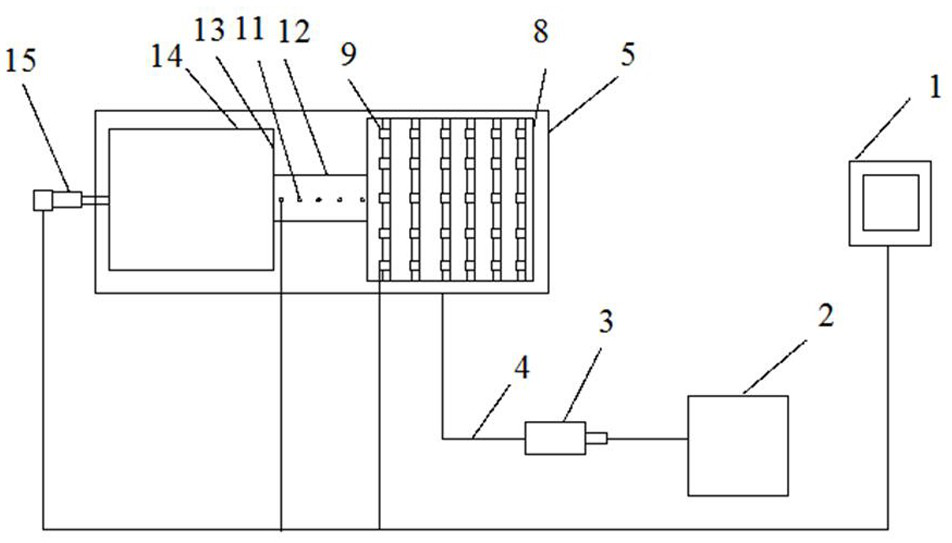Damage simulation experiment system of small emergency equipment under multi-disaster action
A technology for simulating systems and simulating experiments, which is applied in the testing of measuring devices, instruments, machines/structural components, etc. It can solve problems such as complex environments and inability to obtain the degree of damage, achieve a large operable space, and realize repeatable operations , the effect that the material is easy to obtain
- Summary
- Abstract
- Description
- Claims
- Application Information
AI Technical Summary
Problems solved by technology
Method used
Image
Examples
Embodiment 1
[0026] Embodiment 1: In this embodiment, the firefighter's rescue device is used as a test sample. During the experiment, the fireman's rescue device of the tested sample is placed on the sample support 9 in the disaster element receiving device 8, and the first hydraulic support 16 is adjusted so that the slideway 12. The bottom end is 2 m away from the surface of the sample support 9. Adjust the surface of the sample support 9 so that the surface of the test sample is perpendicular to the linear direction of the slideway 12. Add the mixture of rock and soil to the supply tank 14. Adjust the second hydraulic support 18 to make the slideway 12. The inclination angle is 60°. Adjust the first hydraulic support 16 so that the inclination angle of the supply tank 14 is 30°. Five displacement sensors 11 are arranged on the surface of the slideway 12. The distance between two adjacent displacement sensors 11 is 0.6 m. Take Go to the first baffle plate 13 on the side of the supply tan...
Embodiment 2
[0027] Embodiment 2: In this embodiment, the emergency communication equipment is used as a test sample, soil is added to the supply tank 14, the support 18 is adjusted to make the slideway inclination angle 45°, and the hydraulic support 16 is adjusted to make the supply tank 14 inclination angle 45°. Adjust the combined hydraulic support 16 so that the bottom of the slideway 12 is 2 m away from the upper surface of the sample support 9, put down the first baffle 13 on the side of the supply tank 14, and adjust the hydraulic push rod 15 so that the second baffle 19 on the side of the supply tank 14 pushes the soil Sliding, the soil falls on the disaster element receiving device 8 through the slideway 12 to simulate the landslide disaster process. The signal received by the sensor is input to the main control computer 1 through digital-to-analog conversion for data storage and calculation processing, and the data acquisition is closed after 2 hours of the experiment. device.
Embodiment 3
[0028] Embodiment 3: as image 3As shown, in this embodiment, the test samples in the disaster element receiving device 8 are reasonably arranged to study the damage degree of the samples in different positions. The sample holder 9 is set in the disaster element receiving device 8, with 5 rows and 6 columns in total, each The interval between each column is 0.6 m, and the interval between each column is 0.5 m. Helmet lights are selected as experimental samples, and the helmet lights are placed horizontally on the upper surface of the sample support 9 in rows 1, 3, and 5, and the helmet lights are vertically placed in rows 2 and 4. Place on the upper surface of the sample holder 9, wherein the lamp face of the helmet lamp of the second exercise is upward, and the bottom surface of the helmet lamp of the fourth exercise is upward, add rocks into the supply tank 14, adjust the bracket 18 to make the inclination angle of the slideway 12 Adjust the first hydraulic support 16 so tha...
PUM
 Login to View More
Login to View More Abstract
Description
Claims
Application Information
 Login to View More
Login to View More - R&D
- Intellectual Property
- Life Sciences
- Materials
- Tech Scout
- Unparalleled Data Quality
- Higher Quality Content
- 60% Fewer Hallucinations
Browse by: Latest US Patents, China's latest patents, Technical Efficacy Thesaurus, Application Domain, Technology Topic, Popular Technical Reports.
© 2025 PatSnap. All rights reserved.Legal|Privacy policy|Modern Slavery Act Transparency Statement|Sitemap|About US| Contact US: help@patsnap.com



